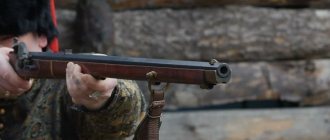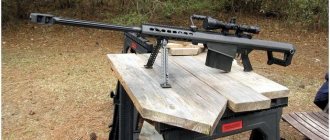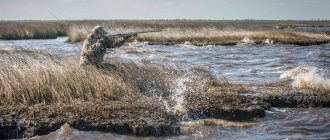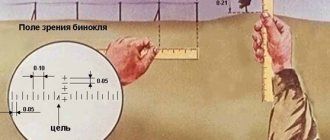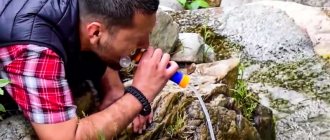The partridge is one of the few birds that can be found both in the forest and in the homestead. Its meat is somewhat similar to chicken, but the size of the bird is noticeably smaller than chicken - the weight of the bird does not exceed 600–700 grams. To hunt partridges, many hunters do not specifically use guns, since the shot literally fills the body of the bird.
Eating shot birds is dangerous, as the shot can easily break a tooth. For fishing, nets and various traps are often used. Birds caught alive can be safely used for food or raised at home.
How to catch a partridge in summer
From spring to autumn, it is extremely difficult to spot partridges in the forest - they are very shy, well camouflaged in the grass and bushes. Experienced hunters know how to track birds using certain signs. However, even tourists or mushroom pickers have probably seen partridges more than once. The bird literally flies out from under the feet of a person who accidentally stumbles upon it, frightening him with the noise of its wings.
This feature of partridges - hiding in the grass until the last - is often used by hunters to catch birds in the summer.
Free network
Now in stores for hunters and fishermen you can buy any net, including one that is suitable for catching birds. However, more often they make the necessary network themselves. They take into account hunting habits, the number of people who will drive the birds, and where the partridges will be caught.
Such a network is usually woven from nylon. The mesh size should not exceed 2–3 cm. The width of the net is 6–7 m, the length is 8–10 m. If it is intended to hunt a very large flock of birds, then hunters prepare several similar nets at once.
The principle of free net fishing is as follows:
- In the place where birds are supposed to be hunted, the net is installed vertically so that its lower edge is located at a height of 1 m above the ground, and its upper edge is no higher than 5–6 m.
- For reliability, the net is bent a little in a zigzag so that it is not tense, but hangs freely. Then the bird flying at it is guaranteed to get confused.
- For installation, use poles or a system of rope braces between trees.
- Once the trap is set, the bird drive begins. The hunters walk in a chain (or in a semicircle) at a distance of 50 m from each other and slowly, without sudden movements, drive the birds hiding in the vegetation towards the net, urging them on with quiet cries.
- Sometimes specially trained hunting dogs are used for corralling.
- The main rule when driving is not to raise the partridges on the wing ahead of time. The birds should fly off the ground just in front of the net. Otherwise, the brood may split into several flocks and scatter. Then you will have to reinstall the trap and wait for the partridges to get together again.
In the case of a particularly successful hunt, when more than a dozen birds are caught in the net, experienced hunters recommend releasing some of the birds to freedom. The reason is that partridges are gregarious birds, living in “families” of 5–20 individuals, but never teaming up with birds from other broods. If most of the “family” is caught, then the remaining birds may simply not survive the winter and will not produce offspring. Accordingly, in a year the hunt will no longer be so successful - due to the fault of the hunters themselves.
In open areas, partridges can easily notice the net, so they install it more often in bushes or places shaded by trees . If hunters use several nets at once, they are usually placed at a short distance from each other. The result is an almost continuous overall network up to 100–300 meters long.
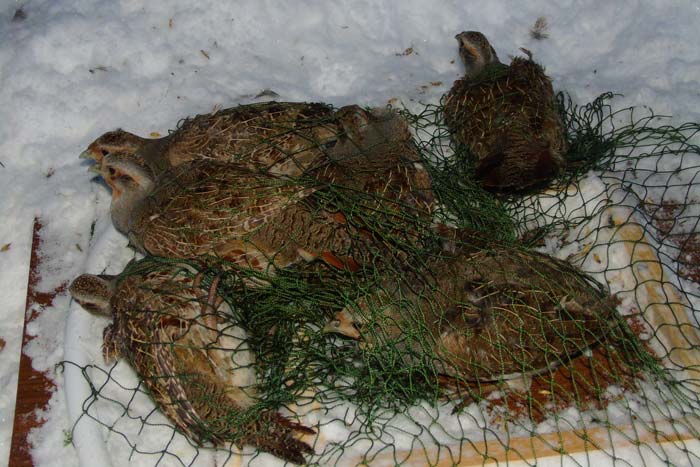
Cone-shaped network
In this case, the method of driving birds by hunters is similar to that described above, but the net used is noticeably different from a free hanging one. A cone-shaped net is woven in the form of a cone up to 6–7 m long, tapering towards one end. The base (the entrance where the birds will be driven) should have a diameter of about a meter. The mesh size of the network is no more than 4 cm.
Two narrow nets in the form of wings up to half a meter wide are attached to the base of the cone; the length of each is from 20 to 100 m. The trap is woven from a thick thread that is clearly visible to partridges.
The main cone-shaped network is installed between a pair of bushes, masking it with branches. The wing nets are spread to the sides with a wedge, secured with pegs above the ground, and the pen is begun.
Birds, running away from hunters, stumble upon wing nets, instinctively run along them and, in the end, find themselves at the entrance of a cone-shaped net, into which birds jump and become entangled in the cells of the cone.
Covering net
This method of fishing is most often used by a lone hunter hunting birds without assistants. To hunt partridges, you can take the same net as used in the free net method, or a slightly smaller one (for example, a square one - 7 by 7 m).
The hunter chooses a place where partridges often appear, sprinkles berries or grain on the ground, pulls a tent-shaped net over the bait so that it can be dropped with one sharp movement of a rope attached to the net, and begins to wait. When the partridges come under the net, the hunter drops it, and the trap covers the birds.
Partridges can no longer get out on their own; the hunter can only get the prey from under the net to put it in a bag. A serious disadvantage of this method of fishing is that sometimes the hunter has to wait a very long time for prey, even if several days before he fed the partridges, accustoming them to the place.

Bird in a net
Summer is a hunter's favorite time. This period is considered the most favorable for catching partridges. One of the common means for hunting birds is nets. This toolkit is made from a special silicone thread. In some cases, a nylon type can be used. The thread divisions should be no larger than 2 cm.
- First you need to choose a place where the most birds are located.
- Traps must be placed at a distance of up to 1 kilometer from the grid in a semicircle shape.
- Every 50 meters there should be a person who will drive the game.
- Since the partridges begin to be afraid, when they fly away, they end up in a net.
- By means of a bag-like fold above the ground, they will get caught and become entangled.
- After this, you simply need to collect the loot and put it in previously prepared bags.
How to catch a partridge in winter
When snow falls, the amount of food in the forest decreases sharply. Birds wintering among trees intensively search for food, and hunters take advantage of this. The basic principle of winter fishing is simple - the bird is lured into a trap with food. If she falls into it, then she is no longer able to get out of the trap on her own.
Before installing the snares, you can feed the birds. The main feeding areas of partridges can be easily determined by tracks in the snow. Grain or other delicacies are scattered there.
Using a snare
Over hundreds of years of hunting, our ancestors came up with many different shaped snares used to catch partridges. However, the basic principle of operation is the same. Loops are made from transparent fishing line, white horsehair or wire. They are attached to a piece of plywood (board) or small traps are made in the shape of pipes or cones. Food pours into the snare.
The trap is sprinkled with snow if the loops are attached to plywood, which is placed on the ground, or partially masked with twigs if it is a three-dimensional structure. When a partridge discovers a trap and tries to eat the bait inside, it becomes entangled, thrashes, and becomes increasingly stuck in the snare.
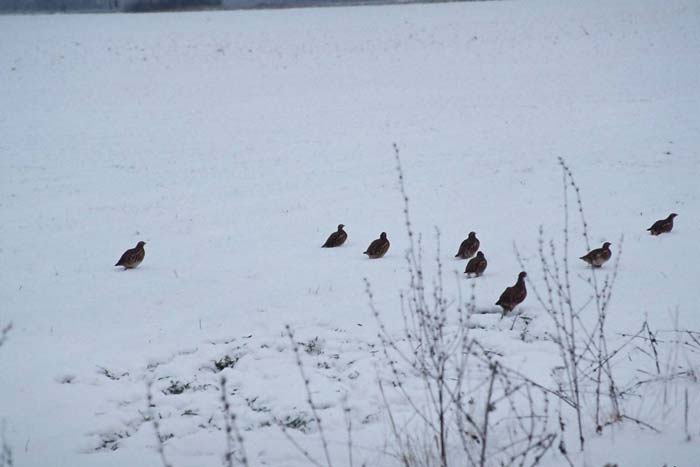
Loops
You can successfully catch partridges with single loops. Making such a trap is not difficult. To do this, take horsehair or a strong nylon thread, invisible in the snow, and weave a rope from it. At one end, a sliding loop is made with a diameter of 6–7 cm (if the loop is to be placed on snow) or 12–13 cm (if the structure is to be suspended above the ground).
They choose a fishing spot in the forest. Usually a ground loop is placed on some hillock, since partridges have a habit of climbing to high places to look around, sprinkle it with snow, and scatter bait on top. If the loop is suspended above the ground, then on the sides of it a kind of passage is formed from twigs, at the end of which food is poured onto the snow under the loop.
Regardless of the fishing method, the second end of the rope with a loop is attached to a tree trunk or bush branch so that the caught bird does not fly away with the rope. When a partridge that has found the bait gets into the loop with its paw or its whole body, the thread is tightened and does not allow the bird to free itself.
Experienced hunters set many traps - up to hundreds. This allows you to catch about 50 individuals per day.
Of course, if a person does not plan to acquire a large livestock, there is no need for so many traps.
Using a bottle
You can catch a partridge without even making snares, loops or nets, but literally with your bare hands. To do this, just take a plastic liter bottle or wine container with a cone-shaped neck, fill it with boiling water and stick the neck into the snow. Boiling water melts the snow through the walls of the bottle, forming an ice crust.
Then the bottle is carefully pulled out of the formed ice hole and food is poured inside. It turns out to be a kind of partridge trap. When a bird finds such a hole with food, it tries to get food from the trap, falls into it upside down and can no longer get out of the icy hole.
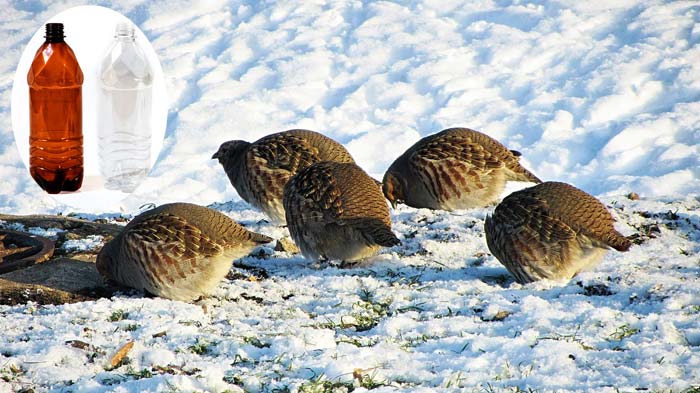
We use a bottle
An unusual, but quite effective method of catching partridge is a bottle. The main tools required for this process are a bottle, a thermos, hot water and, in fact, the “biting material” - bait. In order to prepare this trap, you need:
- To make the trap itself from the bottle: you need to cut three quarters of its length.
- You need to pour boiling water into the thermos (will be needed in the future) and prepare bait (grain or berries).
At first glance, it may seem that this is just a set of incomprehensible actions. Nevertheless, the principle of operation of this trap is quite effective: a partridge, having found food, dives into a hole for bait, gets stuck and is caught. It gets stuck because the small diameter of the hole prevents the bird from spreading its wings to take off.
As an alternative to a plastic bottle, you can use a champagne bottle. The operating principle of this design is the same.
Difficulties of catching
Despite the apparent simplicity of the methods described above, catching partridges without the help of a gun can sometimes be difficult, especially if this is done in order to breed caught birds in a private backyard.
It should be remembered that in the spring any type of hunting for partridges is prohibited by law, since from March to May the birds hatch their offspring.
Hunting partridges from June to August is also not recommended. After a couple of months, young birds still do not have time to get stronger. During capture, they experience such stress that they may simply not take root in captivity. Therefore, experienced hunters advise conducting bloodless partridge hunting from August to the end of February. It is important to consider the following:
- Partridges are well camouflaged among vegetation. It is difficult for an inexperienced person to track them in summer and autumn.
- Even if the habitat of birds is discovered, you need to be able to properly drive them into the net. The partridge is extremely shy. If you scare it sharply, it will hide in the grass and sit quietly until the hunter comes within a few steps of it. Without seeing a bird among dense vegetation, you can pass by it. Therefore, having discovered a brood of partridges, you should drive the birds to the net slowly, without sharp cries.
- Some hunters use dogs to drive partridges. A hunting dog is able to catch a partridge on its own, because this bird cannot fly long distances. It takes off only for a short time, flies in a straight line for a few seconds, and then lands on the ground again. A hardy dog can chase a partridge taking off and landing across a field until it catches it. It is necessary not only to train the four-legged assistant to drive partridges, but also not to maim the caught birds with his teeth. Otherwise, the captured birds will not be suitable for domestication.
- It is much easier to find bird habitats in winter than in summer. However, winter hunting also has its difficulties. You need to be able to carefully camouflage snares and snares in the snow, otherwise the partridge will notice them and may bypass the trap.
- It is difficult for a hunter to sit for a long time without moving in an ambush in the cold. If you don’t stay near the traps all the time, but come to check once a day or less often, then in the trap you can find a bird frozen in the cold or even find only feathers and blood. After all, in the winter forest there is not enough food not only for birds and herbivores, but also for the predators that hunt them - wolves and foxes.

How to make a partridge snare with your own hands
To make the simplest snares, which can be used both in summer and winter, you will need a sheet of DPV (no more than 1 sq. m in size) and strong transparent fishing line. Sequencing:
- Rows of holes are drilled in the base sheet at a distance of 3–5 cm from each other.
- A piece of fishing line is inserted into every two adjacent holes so that a loop with a radius of 3–5 cm rises above the fiberboard; the ends of the fishing line are secured to the back of the base sheet.
- The work is completed when the loops from the fishing line cover the entire sheet of fiberboard.
In the forest, ready-made snares are installed near a bush or tree. In summer they sprinkle with leaves, in winter with snow. Then feed is scattered between the loops.
When a partridge that has found the snare begins to peck at the bait, its paw gets caught in one of the loops and can no longer escape from the trap.
If a hunter uses several similar homemade snares at the same time, he installs them between trees at a distance of at least 20 m from each other.
This is done so that the caught birds do not scare away other partridges from the neighboring snares with their screams and flapping wings.
Loop
In winter, a method is also used that allows you to catch birds with a noose. Craftsmen make suitable loops from fishing line with a cross-section of 0.4 - 0.6 mm, or horsehair. A loop measuring 5–6 mm is made at one end of the fishing line, the second should be securely fastened in the middle of the base. Its role is played by a double thread having a length of 50 cm.
The Pechersk method is known, which allows you to catch birds with loops in winter. It is based on the biological feature of birds, when they climb to any heights they see while searching for food. Preliminary preparation is carried out - they form a hill of snow up to 0.5 m high and up to 0.8 m wide. Willow branches are placed along the edges for bait. A fence is created between them, making sure to provide a door in which a spine is attached to thick rods. The resulting loop is installed at a height of up to 8 meters from the snow thickness. The principle of operation of such a structure is as follows - birds, having discovered a willow tree, peck the buds and run through the doors to another food. At this time, the partridge gets caught in a noose and falls into a pre-made depression in the snow. The distance between the loops is 15 cm or more. You can install up to 70 such devices in a day.
It's easier to install loops in the tundra. Since snow drifts are rare in the forest zone, it is possible to catch about 50 partridges per day on a rod with 200 loops.
It is recommended to monitor the placed loops every 1 - 2 days so that the caught bird does not become prey for ground and feathered predators, or is spoiled by mouse-like rodents.
Another method of catching partridges with a noose is called Intinsky. With it, a mound of snow is made near a dense bush and doors are placed on which a hinge is attached. There is a bush on one side of the elevation, and a depression on the other, so game must pass through the gate. A bait made from willow shoots is placed on both sides of the formed loop. The Vorkuta method is almost no different from the Inta method.
With the Taimyr method, a fishing line with a diameter of about 0.5 mm and a soft wire with a cross-section of more than 1 mm are used to make a loop. The wire is divided into parts, each of which has a length of 50–60 cm. At the end, an eyelet with a diameter of up to 4 mm is created, and a ring with a size of up to 12 mm is attached to it. To carry out the work, use pliers. The finished loop is placed on a peg, the height should be up to 25 cm. The ring should be put on the backbone, the fishing line should hang 10 cm from it. The lower part of a correctly installed loop is located 6–8 cm from the snow surface. An experienced hunter puts up to 300 loops of this design per day.
Making your own trap
One effective way to catch partridges in winter is to use traps. The simplest one can be easily made with your own hands:
- You need to take a sheet of plywood measuring 40x80 cm.
- Thin wooden slats are attached to the plywood at a distance of 3–4 cm from each other. Instead of slats, you can use easily bendable willow rods, which form a kind of closed cage over the plywood sheet.
- On one side of the cage they make a self-closing door with a cable.
In a winter forest, the trap is placed near a bush, so it is easier for it to “merge” with the vegetation. Snow is poured onto the plywood base, and food is scattered in front of the open entrance of the trap and inside it. The partridge, pecking at the bait, goes inside the cage, touches the cable, the door closes, and the bird is locked.
It is more difficult to catch a partridge using a bloodless method than to shoot it with a gun. However, this makes the hunt fair and equalizes the chances of bird and man. On the one hand, the bird has the ability to elude the hunter. On the other hand, the person who caught a partridge without the help of a firearm has more reasons to be proud of himself. In addition, having caught the bird alive, you can domesticate it and continue to regularly eat partridge meat, no longer going hunting.
Winter methods of catching chukars
- bottle
- Network
- By snare
- Loop
Partridge fishing is one of the most popular pastimes among hunters, more common than even hare fishing. Catching wild birds is carried out using similar methods; the main difference is the behavioral characteristics of each bird species.
Before catching partridge using any of the listed methods, you need to understand where they mainly live and what time of year is best to hunt. Most often, partridges are found in bushes and thickets of trees. These are valleys where there are rivers. In winter, it is not easy to notice a partridge; you need to understand where the flock usually gathers. In summer, these birds are also well hidden, but in addition to bushes, they can also be found in tall grass.
One of the easiest ways to hunt without weapons in winter is with homemade traps. They are made with their own hands from different materials: sunflower stems, thin slats, rope mesh. The distance between the slats is no more than 5 cm. The base for the trap is made of plywood or boards, measuring 1 * 1 * 0.5 m. A small door is made on each side, to which a tension rope is attached. Food is scattered inside and around the trap. Seeing the bait, the partridge enters the cage, touches the cable and the door closes.
Most often this method is used in winter hunting, but it is not prohibited in summer. How to make snares for partridges: loops are knitted from copper wire in three strands. Diameter - 12 cm, tail length - 50 cm. With the tail, the loop is attached to a peg or twig.
We invite you to read: Gray partridge hunting highlights
A ready-made trap is installed among snowdrifts and thickets of bushes, where it is easier to catch partridges. Fences are made from willow or birch branches and placed around the traps at a distance of 2 meters. Pegs are installed between them, to which a loop is attached at a height of 15 cm from the ground. You can scatter some food under the traps.
